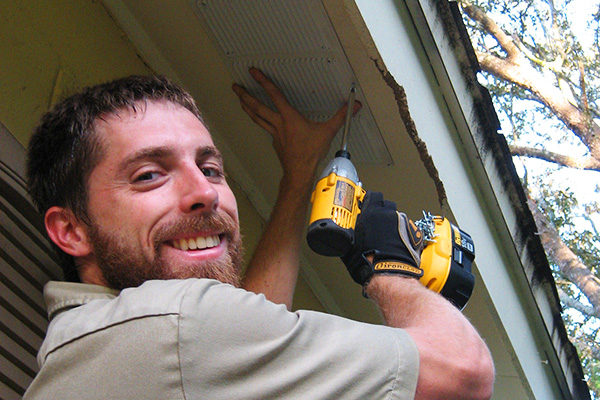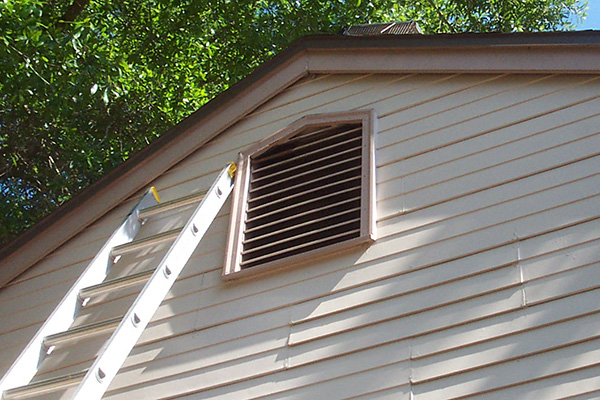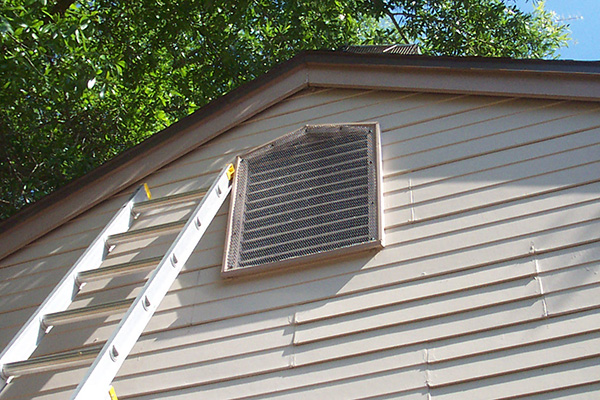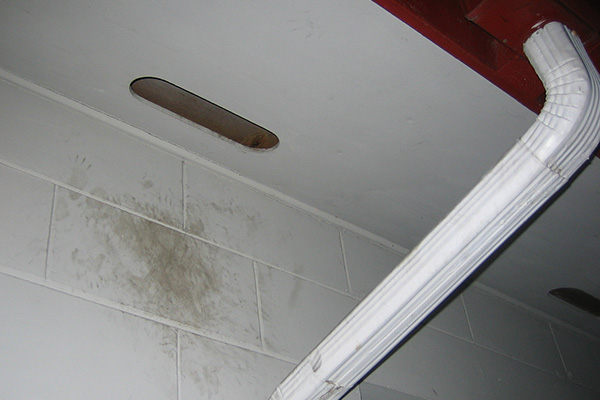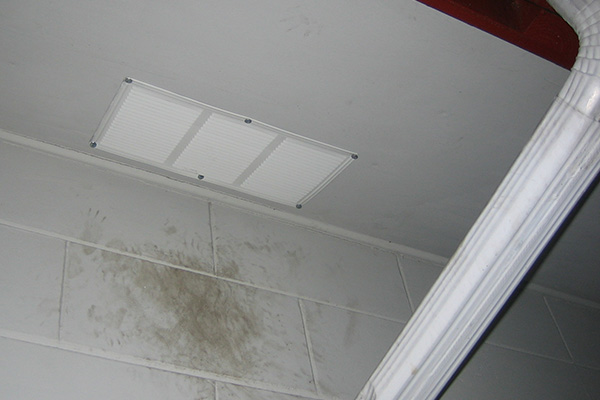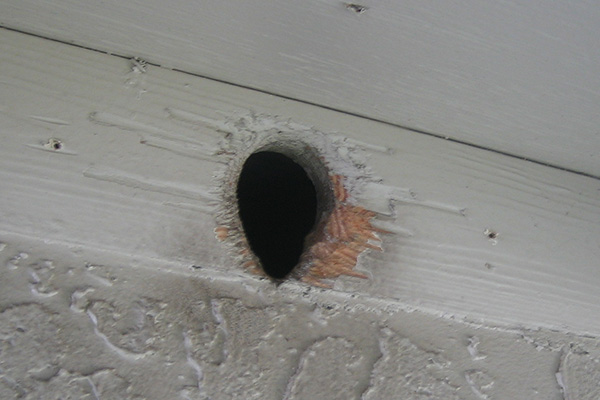- info@animalatticpest.com
- Call - we service 300 locations

Repairs - How to Fix Wildlife Entry Holes
In order to solve the problem of animals in the attic, you must inspect the house, find 100% of the entry holes, and seal those areas shut. Of course, you also have to get the animals out, but sealing the entry
holes is a vital part of the process. Most jobs require sealup of secondary entry points before you even begin removal of the animals, and rat and mouse jobs require complete seal-up BEFORE you even begin trapping.
Your repairs must be good. You must use good tools and materials. You should seal all holes with metal screen or metal flashing. Otherwise, animals will simply chew their way back in. Wood repairs aren't good enough, and
materials like caulk or expanding foam sealant certainly won't suffice. Here are the tools you'll want: A good ladder which allows you access to the roof and all the eaves and other high areas animals use
to enter the house. A power screwdriver is vital to bolt in your repairs with screws, not nails or glue. You want strong repairs. I often use a 90-degree power screw to fit into tight areas.
For most repairs, metal flashing is a great repair material, as is steel screen, also known as hardware cloth. You might want to buy specialty materials such as metal vent covers
or a steel chimney cap for specific areas like a soffit vent or chimney flu. Be sure to keep ventilation considerations in mind when repairing vent covers and plumbing stacks - use steel screen. You can use
caulk or expanding foam for bat work, since bats can't chew, and you can also use it to cover up steel mesh, to block airflow, since animals get into the attic by smelling the different air coming from within. Be sure to be
diligent and attentive and professional in all your repair work.
Repairs - How to Fix Wildlife Entry Holes
Use a Ladder
Inspect the exterior of the home, including the roof and all vents, to find out how the animals are getting in. Most animals in the attic enter at roof level.
Use Good Materials
This is very important. You don't want animals chewing their way back in! Here is a proper soffit vent cover, which is being bolted into the soffit.
Use Metal Flashing and Screws
Rodents like rats, mice, and squirrels can chew. Use metal flashing or metal screen, which the animals are unable to chew through. Wood repairs won't cut it!
Information About Repairs - How to Fix Wildlife Entry Holes
Repairs – How To Fix Wildlife Entry Holes
If you want to get wildlife out of your home and keep them out, you need to do more than just trap and release or practice exclusion. You also need to ensure you seal up every single entry hole that leads into your home, whether it was there before the wild animal arrived or the wildlife made it. If a single hole remains, you will be facing the possibility of more animals coming into your house and taking the spot of whichever one you just kicked out.
Use High Quality Materials
The most important thing to remember when repairing wildlife entry holes is to use high quality materials. Skimping on materials can end up costing you more in the long run since you will need to replace them more frequently. It can also lead to time consuming and expensive efforts to remove wildlife again in the near future. After all, an animal can easily bite through thin mesh but won’t be able to do the same with thick steel mesh. If you need to buy specialty materials such as steel chimney caps or metal vent covers, do so. You will save money in the long run and prevent frustration. Be sure to get some basics like a ladder, a power screwdriver, sturdy screws, steel screens, and metal flashing. Don’t forget a sturdy sealant for those little nooks and crannies or gaps around windows.
Finding The Holes
Before you can start fixing the wildlife entry holes in your home, you will need to find them. An expert will know exactly where to look based on where wildlife typically tries to get inside the home. Whether or not you hire a professional to find and repair the holes for you, there will need to be a thorough inspection of your home from top to bottom. If you are going through the trouble of sealing the entry points in your attic, make sure you do the same in your basement and walls as well. Some of the most common entrances to look out for include damaged vents or soffits in the roof, damaged or loose masonry in the walls, loose roof tiles, uncovered chimneys, open spots under the deck or porch, plumbing stacks, and the area where your roof meets the dormers or soffits. Check these areas more closely but inspect your entire home.
Holes In Walls And Basements
Depending on the size of the animal entry point in the wall or your basement, you may need to replace some of the bricks in the construction or simply invest in some sort of filler. Your walls provide protection to your home and provide structural integrity so you don’t want to compromise their structure and supporting capabilities. If the hole is minor, simply fill it up with drywall and other similar materials and paint over it. For larger holes, have a professional take a look so you can be sure wildlife can’t break through your repairs and that the walls will be able to stand up to their normal use.
Holes In Roofs And Attics
In most cases, entry holes in the attic or roof will be smaller since these are typically used by squirrels, bats, and other small animals. That being said, you may find a bigger hole from a raccoon or other animal. Follow the same general method you would use for any other attic or roof repairs, replacing tiles and supporting materials as needed and opting for sturdy materials. In the case of damaged vents, replace it with a new one and install sturdy wire mesh over it. This will reduce the risk of animals getting inside. Even though the animals enter from outside, don’t forget to search inside the attic on the underside of the roof for signs of other damage or entry points.
Damage To Chimneys
Depending on the animal in question, you may also find yourself repairing damage to your chimney. Whether or not this area was damaged, you should install a chimney cap of some sort so animals cannot get into the chimney in the future. In some cases, you will only need to replace the chimney cap but in other situations, you may also need repairs done to the structure of the chimney. Be sure that no gaps between the chimney cap and masonry are exposed since small animals can get inside these or enlarge them.
Leave It To The Pros
For those with a great deal of time on their hands and some experience with home repairs, it is possible to fix animal entry points yourself. That being said, the average homeowner will have a much easier time if they hire a professional. These experts will know where to look for potential entry points and know the best methods of sealing them up. They can also offer other suggestions to make your property less attractive for wildlife.
The Bottom Line
You won't solve the problem without professional repairs. 'Nuff said.


